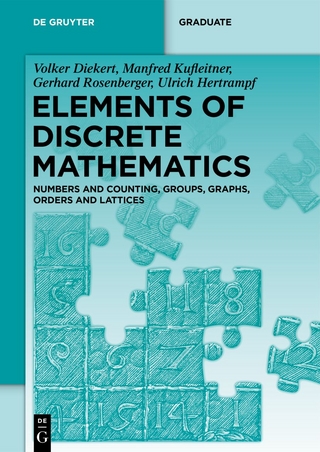
Combinatorial Methods in Discrete Mathematics
Seiten
2011
Cambridge University Press (Verlag)
978-0-521-17276-9 (ISBN)
Cambridge University Press (Verlag)
978-0-521-17276-9 (ISBN)
A 1996 account of some complex problems of discrete mathematics in a simple and unified form. A distinctive aspect of the book is the large number of asymptotic formulae derived. This is an important book, describing many ideas not previously available in English; the author has taken the chance to update the text and references where appropriate.
Originally published in 1996, this is a presentation of some complex problems of discrete mathematics in a simple and unified form using an original, general combinatorial scheme. The author's aim is not always to present the most general results, but rather to focus attention on ones that illustrate the methods described. A distinctive aspect of the book is the large number of asymptotic formulae derived. Professor Sachkov begins with a discussion of block designs and Latin squares before proceeding to treat transversals, devoting much attention to enumerative problems. The main role in these problems is played by generating functions, which are considered in Chapter 3. The general combinatorial scheme is then introduced and in the last chapter Polya's enumerative theory is discussed. This is an important book, describing many ideas not previously available in English; the author has taken the chance to update the text and references where appropriate.
Originally published in 1996, this is a presentation of some complex problems of discrete mathematics in a simple and unified form using an original, general combinatorial scheme. The author's aim is not always to present the most general results, but rather to focus attention on ones that illustrate the methods described. A distinctive aspect of the book is the large number of asymptotic formulae derived. Professor Sachkov begins with a discussion of block designs and Latin squares before proceeding to treat transversals, devoting much attention to enumerative problems. The main role in these problems is played by generating functions, which are considered in Chapter 3. The general combinatorial scheme is then introduced and in the last chapter Polya's enumerative theory is discussed. This is an important book, describing many ideas not previously available in English; the author has taken the chance to update the text and references where appropriate.
Preface; Preface to the English edition; Introduction; 1. Combinatorial configurations; 2. Transversals and permanents; 3. Generating functions; 4. Graphs and mappings; 5. The general combinatorial scheme; 6. Polya's theorem and its applications; Bibliography; Index.
| Erscheint lt. Verlag | 2.6.2011 |
|---|---|
| Reihe/Serie | Encyclopedia of Mathematics and its Applications |
| Übersetzer | V. Kolchin |
| Zusatzinfo | Worked examples or Exercises |
| Verlagsort | Cambridge |
| Sprache | englisch |
| Maße | 156 x 234 mm |
| Gewicht | 450 g |
| Themenwelt | Mathematik / Informatik ► Mathematik ► Graphentheorie |
| ISBN-10 | 0-521-17276-4 / 0521172764 |
| ISBN-13 | 978-0-521-17276-9 / 9780521172769 |
| Zustand | Neuware |
| Haben Sie eine Frage zum Produkt? |
Mehr entdecken
aus dem Bereich
aus dem Bereich
Numbers and Counting, Groups, Graphs, Orders and Lattices
Buch | Softcover (2023)
De Gruyter (Verlag)
64,95 €
